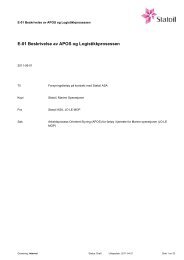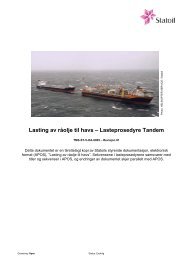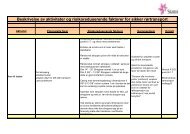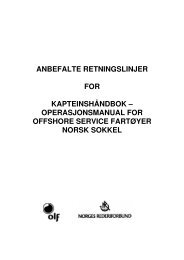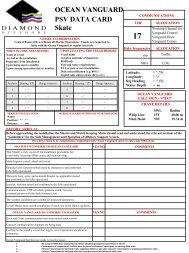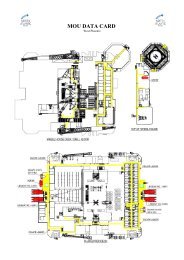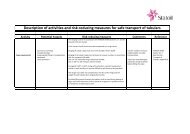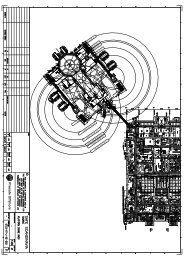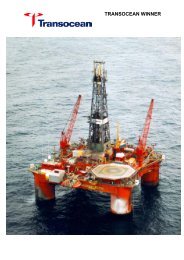Statoil spesifikke retningslinjer. Tilegg til NWEA og OLF ...
Statoil spesifikke retningslinjer. Tilegg til NWEA og OLF ...
Statoil spesifikke retningslinjer. Tilegg til NWEA og OLF ...
You also want an ePaper? Increase the reach of your titles
YUMPU automatically turns print PDFs into web optimized ePapers that Google loves.
<strong>Statoil</strong>-specific guidelines<br />
Supplemental to <strong>NWEA</strong> and Operations manual for OSV<br />
NcS<br />
Classification: Open Status: Final Expiry Date: 2013-02-01 Page 1 of 19
Title:<br />
<strong>Statoil</strong>-specific guidelines<br />
Supplemental to <strong>NWEA</strong> and Operations manual for OSV NcS<br />
Document no.: Contract: Project:<br />
Classification: Distribution:<br />
Open Free distribution<br />
Expiry Date: Status<br />
2013-02-01 Final<br />
Date of publication: Rev No: Copy no.:<br />
2010-03-01 1.5<br />
Author(s)/Source(s):<br />
<strong>Statoil</strong> Marine Operations<br />
Relates to (specific discipline/catchwords)<br />
<strong>Statoil</strong>-specific part of the Operations Manual for OSV’s Ncs<br />
Notes:<br />
Versjon 1.5 updated 01.08.2012<br />
Enters into force: Update:<br />
2010-03-01 2012-08-01<br />
Responsible for publishing: Authority to approve nonconformities :<br />
MOP Marine operations Marine operations<br />
Discipline Leader (Organizational unit): Discipline Leader (name): Date/Signature:<br />
JO LE MOP Kje<strong>til</strong> Vea<br />
Prepared (Organizational unit): Prepared (name): Date/Signature:<br />
JO LE MOP Marine Operations<br />
Recommended (organizational unit): Recommended (name): Date/Signature:<br />
JO LE MOP Ole Steinar Anderssen<br />
Authorised (organizational units): Authorised (name): Date/Signature:<br />
ODV LE MOP Morten Meinich 2010-03-01<br />
Classification: Open Status: Final Expiry Date: 2013-02-01 Page 2 of 19
<strong>Statoil</strong>-specific guidelines<br />
Supplemental to <strong>NWEA</strong> and Operations manual for<br />
OSV Ncs<br />
Table of Contents:<br />
Doc. no.<br />
Enters into force Rev. no.<br />
2010-03-01 5<br />
1 General........................................................................................................................................................... 4<br />
1.1.1 Purpose........................................................................................................................................................... 4<br />
1.1.2 Validity ............................................................................................................................................................ 4<br />
1.1.3 The captain's responsibility ............................................................................................................................. 4<br />
1.1.4 The crew's qualifications ................................................................................................................................. 5<br />
1.2 <strong>Statoil</strong> Marin .................................................................................................................................................... 5<br />
1.3 Operation at the installations .......................................................................................................................... 5<br />
1.3.1 Requirements related to manning within the safety zone ............................................................................... 6<br />
1.4 Transfer of personnel using MOB boat in open sea ....................................................................................... 6<br />
1.5 Crew change at the quay ................................................................................................................................ 7<br />
2 HSE................................................................................................................................................................. 7<br />
3 Field information and special routines on the Shelf ................................................................................. 7<br />
3.1.1 Permanent installations (Appendices) ............................................................................................................ 7<br />
3.1.2 Mobile facilities (Appendices) ......................................................................................................................... 7<br />
3.1.3 Special conditions ........................................................................................................................................... 7<br />
3.1.4 ISPS Form (Appendix) .................................................................................................................................... 9<br />
3.1.5 Procedures for bulk-hose handling (Appendix) ............................................................................................... 9<br />
3.1.6 Communication ............................................................................................................................................... 9<br />
4 Supply service and mobilisation of equipment at the bases.................................................................... 9<br />
4.1.1 Base information ............................................................................................................................................. 9<br />
4.1.2 Special care when carrying noxious and hazardous products in bulk. ......................................................... 10<br />
4.1.3 Bunkering and transportation of diesel oil ..................................................................................................... 10<br />
4.1.4 Transportation and handling of methanol ..................................................................................................... 12<br />
4.1.5 Transport of freshwater to offshore installations ........................................................................................... 12<br />
4.1.6 Cleaning of tanks .......................................................................................................................................... 12<br />
4.1.7 ARIS.............................................................................................................................................................. 12<br />
5 Emergency preparedness service............................................................................................................. 13<br />
5.1.1 Emergency preparedness, own vessel ......................................................................................................... 13<br />
6 Notification & Reporting ............................................................................................................................. 13<br />
6.1.1 HSE Notification ............................................................................................................................................ 13<br />
6.1.2 HSE reporting ............................................................................................................................................... 14<br />
6.1.3 Operational nonconformities ......................................................................................................................... 14<br />
6.1.4 Daily operations – Vessel l<strong>og</strong> – delivery/redelivery....................................................................................... 14<br />
7 Anchor handling and rig move operations ............................................................................................... 14<br />
8 IMR and survey operations ........................................................................................................................ 15<br />
9 Auditing, handling of nonconformities and follow-up ............................................................................ 17<br />
9.1.1 Auditing ......................................................................................................................................................... 17<br />
9.1.2 Handling of nonconformities ......................................................................................................................... 17<br />
9.1.3 Important safety-related information ............................................................................................................. 17<br />
9.1.4 L<strong>og</strong> ................................................................................................................................................................ 17<br />
Grade: Open Status: Final Expiry Date: 2013-02-01 Page 3 of 19
<strong>Statoil</strong>-specific guidelines<br />
Supplemental to <strong>NWEA</strong> and Operations manual for<br />
OSV Ncs<br />
1 General<br />
1.1.1 Purpose<br />
Doc. no.<br />
Enters into force Rev. no.<br />
2010-03-01 5<br />
The purpose of this manual is to provide the crews on board offshore service vessels operating for <strong>Statoil</strong> with<br />
information related to the functions the vessels shall perform. The supplement must be seen in the context of<br />
<strong>NWEA</strong>'s and Operations manual for OSV NcS.<br />
A drawing illustrating how this is to be read and understood can be seen in Chapter 1 of Operations manual for<br />
OSV NcS<br />
1.1.2 Validity<br />
This supplement to Operations manual for OSV NcS is applicable for anchor handling, standby, guard and<br />
supply vessels operating for JO LE MOP (<strong>Statoil</strong> Marine Operations) on the Norwegian Continental Shelf.<br />
It is also valid for other vessels operating for <strong>Statoil</strong> on order from the principal or <strong>Statoil</strong> representative<br />
onboard the vessel. This has been more described in more detail for IMR and survey vessels in chapter 8.<br />
A valid version of the document will always be available on: www.nwea.INFO under the company's l<strong>og</strong>o.<br />
Proposals for improvements and comments to these company-specific supplements can be given to<br />
ruhmo@statoil.com marked ”The Masters Manual”<br />
1.1.3 The captain's responsibility<br />
Nothing in these guidelines limit the responsibilities of the captain under national and/or international statutes,<br />
regulations and conventions.<br />
The responsibilities of a captain on an offshore service vessel in service for <strong>Statoil</strong> are the following:<br />
� Ensure that the vessel complies with the routines as described in:<br />
o <strong>NWEA</strong>,<br />
o Norsok R-003<br />
o Operations manual for OSV NcS<br />
o The vessel’s contract with <strong>Statoil</strong> and/or service provider<br />
o This specific supplement<br />
o Information received from <strong>Statoil</strong> during the contract period.<br />
� Ensure that the vessel follows the requirements and methods which are described for responsible<br />
vessel cf. <strong>Statoil</strong>'s management system ARIS<br />
� Observe the sailing orders from <strong>Statoil</strong> Marin. IMR and survey vessels shall follow the sailing order<br />
from <strong>Statoil</strong>'s representative onboard.<br />
� Ensure that the vessel operates at "environmental friendly speed" unless other instructions have been<br />
given.<br />
� Be proactive, and continuously assess nonconformities in relation to the sailing order.<br />
� Ensure that no alcohol or other substances are used by the crew during the contract period.<br />
Grade: Open Status: Final Expiry Date: 2013-02-01 Page 4 of 19
<strong>Statoil</strong>-specific guidelines<br />
Supplemental to <strong>NWEA</strong> and Operations manual for<br />
OSV Ncs<br />
Doc. no.<br />
Enters into force Rev. no.<br />
2010-03-01 5<br />
� Ensure that the crew's qualifications are in accordance with statutory requirements, industry<br />
guidelines, as well as the vessel's specific contract.<br />
� Ensure that all third party costs which <strong>Statoil</strong> shall pay according to the contract, are paid by the<br />
shipping company for re-invoicing, unless otherwise specifically agreed.<br />
If the captain doubts whether he has received sufficient information about the task to be carried out, <strong>Statoil</strong><br />
Marin or the <strong>Statoil</strong> representative onboard must be informed.<br />
1.1.4 The crew's qualifications<br />
Anchor handling, standby, guard and supply vessels operating for JO LE MOP, shall upon each crew change<br />
submit the ongoing crew's qualifications to sjotran@statoil.com (A model form for recording the crew's<br />
qualifications can be found in Appendix C-01)<br />
In the event of a nonconformity situation regarding crew competence, the shipping company must describe the<br />
compensating and/or corrective measures to be implemented. The shipping company shall handle any such<br />
non-conformities.<br />
<strong>Statoil</strong> must be familiar with how the shipping companies handle such matters, and may in special cases<br />
request the shipping companies to consider further actions to deal with a specific case.<br />
IMR and survey vessels shall send POB data to POB@<strong>Statoil</strong>.com in agreement with the <strong>Statoil</strong> representative<br />
onboard.<br />
1.2 <strong>Statoil</strong> Marin<br />
<strong>Statoil</strong> Marin carries out the function”Traffic control centre” for <strong>Statoil</strong>, cf. Operations manual for OSV NcS<br />
<strong>Statoil</strong> Marin (SM) is the surveillance centre in Bergen and acts as a single point of contact for the vessel at<br />
sea. The centre is manned 24 hours a day. Its main task is continuous surveillance and coordination of<br />
maritime activities. Contact details for <strong>Statoil</strong> Marine are described in Appendix D-01.<br />
<strong>Statoil</strong> Marin provides access to portals such as VTMIS and the weather portal.<br />
IMR and survey vessels use OAN as described in OM01.14 collecting WPs and bridging with the installations.<br />
A daily status report describes the vessel's movements during the last 24 hours and for the next 48.<br />
1.3 Operation at the installations<br />
Vessels on their way to offshore installations shall not use these as "way points" or steer courses across safety<br />
zones, unless clarified by <strong>Statoil</strong> Marin.<br />
Vessels must not enter the safety zone un<strong>til</strong> the checklist for entering has been reviewed.<br />
<strong>Statoil</strong>'s specific checklist for entering the safety zone is available as a separate Appendix (A-4).<br />
Grade: Open Status: Final Expiry Date: 2013-02-01 Page 5 of 19
<strong>Statoil</strong>-specific guidelines<br />
Supplemental to <strong>NWEA</strong> and Operations manual for<br />
OSV Ncs<br />
Doc. no.<br />
Enters into force Rev. no.<br />
2010-03-01 5<br />
Distance and weather criteria are described in detail in <strong>NWEA</strong> NO 08.<br />
Vessels without technical redundancy shall operate in accordance with the requirements in <strong>NWEA</strong> 3.3.4.3.<br />
<strong>Statoil</strong> has also prepared separate operational limitations for vessels without technical redundancy. These are<br />
covered in Appendix D-06<br />
Office on duty shall make himself familiar with all forbidden zones and area inside safety zone which requires<br />
special awareness. Special caution must be shown to Mobile units and anchor lines.<br />
Special cases:<br />
If an situation arises which requires operations to be carried out, exceptions can be made concerning minimum<br />
distance and weather criteria, provided that a qualified safe job analysis has been conducted. The Offshore<br />
Installation Manager (OIM) shall send a written justification for the nonconformity to the vessel's captain.<br />
T<strong>og</strong>ether the OIM and the captain shall review the check list for handling of nonconformity, safe distance<br />
operation at installations (Appendix C-C-06 Checklist for nonconformity in relation to minimum requirement for<br />
distance), and agree that the planned operation can be conducted.<br />
1.3.1 Requirements related to manning within the safety zone<br />
The minimum requirements for all vessels are described in this section. Extra requirements may apply in<br />
connection with certain operations and contracts.<br />
There shall always be 2 navigators on the bridge, regardless of operation. In connection with DP operations, at<br />
least one of the navigators must be a certified DP operator, and the other one must, as a minimum, have basic<br />
training.<br />
For supply vessels, there must always be 4 navigators onboard. The distribution of tasks (roles and<br />
responsibilities) for the navigators on the bridge must be described in a bridge procedure.<br />
The engine room shall always be manned with qualified personnel.<br />
The safety zone may be larger than 500 m. Reference is made to Efs no. 01 every year for detailed description.<br />
In case of doubt, contact <strong>Statoil</strong> Marin.<br />
1.4 Transfer of personnel using MOB boat in open sea<br />
Transportation of personnel between vessels in open sea with MOB boat entails risk for personnel who are not<br />
trained in such operations. With the exception of crew change on standby vessels, where transfer with MOB<br />
boat is a scheduled part of the crew's drilling activity, transfer of personnel with MOB boat in open sea should<br />
therefore be limited to situations where there are weighty operational or personal reasons.<br />
Criteria for this and the application procedure are described in detail in Appendix D-05.<br />
In the event of transfer between vessels with their own <strong>Statoil</strong> representatives onboard, the representative will<br />
be able to give the company's consent. Please refer to Chapter 8 for details.<br />
Grade: Open Status: Final Expiry Date: 2013-02-01 Page 6 of 19
<strong>Statoil</strong>-specific guidelines<br />
Supplemental to <strong>NWEA</strong> and Operations manual for<br />
OSV Ncs<br />
1.5 Crew change at the quay<br />
2 HSE<br />
Doc. no.<br />
Enters into force Rev. no.<br />
2010-03-01 5<br />
Crew change shall, as far as possible, take place in accordance with the rotation plan. Any service work that<br />
may delay normal time of departure shall always be clarified in advance. Normal time of departure is 1600.<br />
For vessels with their own <strong>Statoil</strong> representative onboard, this is to be clarified by the <strong>Statoil</strong> representative.<br />
The shipping company and the vessel's management are responsible for planning, conducting and following up<br />
all processes related to the deliveries in such a way that safety and efficiency is handled in a satisfactory<br />
manner. It is the captain's responsibility to ensure that none of the crew participates in operations for <strong>Statoil</strong><br />
without knowing how the tasks are to be carried out, including any hazard and risk issues.<br />
All offshore service vessels on assignment for <strong>Statoil</strong> which are in the vicinity of runs for pipelines carrying oil or<br />
gas, are required to report to <strong>Statoil</strong> Marin or the <strong>Statoil</strong> representative onboard if they observe oil or gas which<br />
is likely to come from a leakage on the pipeline network.<br />
Procedures for HSE reporting and notification for anchor handling, standby, duty and supply vessels operating<br />
for JO LE MOP (<strong>Statoil</strong> marine operations) are described in detail in Chapter 6<br />
In their performance of the task, IMR and survey vessels shall follow the detailed orders from the <strong>Statoil</strong><br />
representative onboard.<br />
3 Field information and special routines on the Shelf<br />
3.1.1 Permanent installations (Appendices)<br />
Specific data charts/maps from the permanent installations are available as separate Appendices. (A-1)<br />
3.1.2 Mobile facilities (Appendices)<br />
Specific data charts/maps from the mobile facilities are available as separate Appendices. (A-2)<br />
3.1.3 Special conditions<br />
The following are conditions to pay special attention to. For general information and data charts/maps,<br />
reference is made to the installation-specific Appendices in the preceding section.<br />
In addition to the issues described below, special attention is required for all vessels manoeuvring in the vicinity<br />
of loading systems for buoy loaders. (Se attachment A-8)<br />
Troll A:<br />
There is occasionally a strong ocean current in the Troll A area. Therefore, extra attention is required in this<br />
connection, particularly in loading/unloading operations along the platform. The current varies with the<br />
meteorol<strong>og</strong>ical and ocean<strong>og</strong>raphic conditions in the rest of the North Sea, but it usually has a north-easterly<br />
Grade: Open Status: Final Expiry Date: 2013-02-01 Page 7 of 19
<strong>Statoil</strong>-specific guidelines<br />
Supplemental to <strong>NWEA</strong> and Operations manual for<br />
OSV Ncs<br />
Doc. no.<br />
Enters into force Rev. no.<br />
2010-03-01 5<br />
direction. In combination with winds, this may periodically reduce the manoeuvrability along the platform more<br />
than for other fields. Operating on the south side in southerly winds combined with current is therefore very<br />
unfavourable.<br />
Gullfaks:<br />
On Gullfaks there are sensitive detectors installed which may be affected by welding flashes. Consequently,<br />
welding on deck, etc. must not take place on vessels within a radius of 1000 m (one thousand metres) from the<br />
above mentioned platforms.<br />
Snorre A:<br />
Complicated pattern of movement: Snorre A is an installation constructed according to the tension leg principle.<br />
The platform is therefore in constant motion. It is important that vessels servicing Snorre A are aware that there<br />
is no known symmetry in the platform's pattern of movement; there is no apparent connection between the<br />
platform's movements and the weather/sea condition.<br />
Restricted zones: On the east and west side of Snorre A, drop zones of 200 and 250 metres have been<br />
established for free fall lifeboats. Vessels are not allowed to enter these zones without checking with the<br />
platform. Also when moving from north to south and vice versa, the vessel must keep clear.<br />
Snorre B:<br />
Unprotected risers on the east side.<br />
Power line to Snorre A on the west side.<br />
The east side of Snorre B is a prohibited zone for vessels. This applies within a sector from 060 to 120 degrees<br />
and 250 m outside the platform. For safety reasons all loading and unloading must take place on the north or<br />
south side of the platform. Movements north/south - south/north must take place on the leeward side of the<br />
platform, outside the prohibited zone and at an good distance from the power line. Vessels shall not wait on the<br />
east or windward side of the platform.<br />
Heidrun:<br />
Loading buoy type STL with position N 65° 20.70' and E 007° 18.475'.<br />
Subsea buoy DSL 1 (dir. 107°) and DSL 2 (dir. 050°) 1.7 nautical mile from Heidrun TLP.<br />
The platform moves in a figure of 8. Consequently extra attention is required for vessels that carry out<br />
operations at the platform.<br />
The safety zone around Heidrun is 550 metres and 580 metres around the loading buoys DSL 1 and 2,<br />
compared with the normal 500 metres.<br />
Njord<br />
No vessels must stay within the safety zone in a sector between NE and SE without special permission. Supply<br />
vessels and other vessels dedicated to Njord A shall wait on the leeward side of the installation.<br />
Visund<br />
Visund has restricted zones to the west and to the east (045 degrees to 135 degrees). These extend to the<br />
outskirts of the safety zone. See data map in Appendix A-1.29 for detailed description<br />
Grade: Open Status: Final Expiry Date: 2013-02-01 Page 8 of 19
<strong>Statoil</strong>-specific guidelines<br />
Supplemental to <strong>NWEA</strong> and Operations manual for<br />
OSV Ncs<br />
Brage:<br />
Doc. no.<br />
Enters into force Rev. no.<br />
2010-03-01 5<br />
See separate Appendix (A-3) for special safety measures on Brage<br />
3.1.4 ISPS Form (Appendix)<br />
The ISPS declaration form must be used in connection with interaction between vessels and installations which<br />
are not certified according to the ISPS code. Appendix (A-5).<br />
3.1.5 Procedures for bulk-hose handling (Appendix)<br />
Procedures for bulk-hose handling in <strong>Statoil</strong> are described in detail in a separate Appendix (A-6)<br />
3.1.6 Communication<br />
Installation-specific contact information, as well as a UHF ship frequency plan is enclosed as an appendix. The<br />
UHF ship frequency plan is revised as required every sixth month. See Appendix (D-02),( D-07.01) and (D-<br />
07.02) Communication requirements when interacting with an installation in a lifting operation, as described in<br />
NORSOK R-003<br />
4 Supply service and mobilisation of equipment at the bases<br />
4.1.1 Base information<br />
The vessels' personnel must follow the established safety procedures which apply to the various bases they<br />
call at.<br />
The different bases are all ISPS-certified. All vessels are required to familiarise themselves with and follow the<br />
applicable procedures for calling at the different bases.<br />
Contact details and general information on the various supply bases used by <strong>Statoil</strong> are included as separate<br />
appendices to this document. This includes the following bases:<br />
� Dusavik (Appendix B-01)<br />
� CCB Ågotnes (Appendix B-02)<br />
� Mongstadbase (Appendix B-03)<br />
� Fjordbase Florø (Appendix B-04)<br />
� Vestbase Kristiansund (Appendix B-05)<br />
� Helgelandbase Sandnessjøen (Appendix B-06)<br />
� Polarbase Hammerfest (Appendix B-07)<br />
A total overview of duty telephone numbers for the various <strong>Statoil</strong> supply bases are included in Appendix B-08.<br />
More base-specific information than what is described in these appendixes may be obtained in connection with<br />
port calls or operations at the various <strong>Statoil</strong> supply bases. These may include, but are not limited, to the<br />
following:<br />
� Location and date/time of cargo meetings<br />
Grade: Open Status: Final Expiry Date: 2013-02-01 Page 9 of 19
<strong>Statoil</strong>-specific guidelines<br />
Supplemental to <strong>NWEA</strong> and Operations manual for<br />
OSV Ncs<br />
� Routines for water filling and sampling<br />
� UHF frequency overview at the base<br />
Doc. no.<br />
� Limitations on carrying out hot work on the vessel<br />
� Expanded contact information<br />
� Limitation on carrying out vessel washdown<br />
Enters into force Rev. no.<br />
2010-03-01 5<br />
Routines for mooring at <strong>Statoil</strong>'s supply bases are described in detail in Appendix B-09.<br />
Routines for loading operations are described in <strong>NWEA</strong> and Chapter 6 of Operations manual for OSV NcS.<br />
During loading operations at <strong>Statoil</strong>'s supply base, the cargo officer designated to monitor the loading must<br />
maintain radio communication with the people carrying out the loading, i.e. the crane operator and slinger.<br />
No other harbours than <strong>Statoil</strong>'s supply bases are described in these guidelines.<br />
4.1.2 Special care when carrying noxious and hazardous products in bulk.<br />
We emphasise that the routines described in <strong>NWEA</strong>, for carrying noxious and hazardous products in bulk,<br />
including wet return bulk from the installations, must be followed. To minimise the risk of H2S development, wet<br />
return bulk must not be loaded in tanks which already contain other fluids.<br />
The vessel must also have procedures for all types of bulk operations. The procedures shall as a minimum<br />
describe:<br />
� Safe method<br />
� Precautions for loading and unloading incl. communication and requirements related to documentation<br />
� Risk of harmful evaporation from tank ven<strong>til</strong>ation must be considered. Based on this risk, routines for<br />
regular measuring, recommended to at least every 6 th hour and the establishment of safe zone must<br />
be conducted.<br />
� Use of personal protective equipment<br />
� Notification and emergency preparedness routines related to personal exposure, harmful evaporation<br />
and/or spill onboard, or discharge to the external environment.<br />
4.1.3 Bunkering and transportation of diesel oil<br />
When bunkering diesel and UREA, <strong>Statoil</strong>'s framework agreements shall be used.<br />
Diesel shall always be ordered from <strong>Statoil</strong>'s supply base. In order to ensure correct taxation, the next<br />
destination shall always be stated on the delivery note.<br />
If next destination is other than <strong>Statoil</strong> offshore installation, invoice for bunkering is to be sent to shipsowner<br />
Vessel shall register density according to “Bunker delivery note” at 15 degrees C in Vessel l<strong>og</strong> when bunkering<br />
/ delivering MGO<br />
Grade: Open Status: Final Expiry Date: 2013-02-01 Page 10 of 19
<strong>Statoil</strong>-specific guidelines<br />
Supplemental to <strong>NWEA</strong> and Operations manual for<br />
OSV Ncs<br />
Doc. no.<br />
Enters into force Rev. no.<br />
2010-03-01 5<br />
If loading UREA, this shall be filled into vessel l<strong>og</strong> with time and quantum.<br />
The use of UREA to be offset at delivery / redelivery<br />
All sections handling oil products must have routines implemented to safeguard the quality of the product.<br />
Supply vessels are responsible for diesel oil from bunkering at the quay un<strong>til</strong> delivery at the installation. In order<br />
to meet the quality requirements, vessels must have a "quality plan for diesel” established and implemented,<br />
describing how the vessel will meet and document the quality requirements.<br />
The design and arrangement of storage tanks for diesel oil often entail that<br />
� Efficient drainage of water from tanks is difficult, and the cause of microbiol<strong>og</strong>ical growth can therefore<br />
not be removed.<br />
� Sampling becomes random and unreliable, and the samples taken are not representative.<br />
This means that good procedures are essential to control microbiol<strong>og</strong>ical growth in diesel. Such procedures<br />
must therefore be established and implemented to ensure and document the quality of the transportation<br />
element which the vessel constitutes.<br />
The vessel's quality plan must, as a minimum, describe requirements related to the following:<br />
Quality objective<br />
Objective to be reached in connection with transport of diesel.<br />
Operating routines<br />
Routines relating to bunkering and delivery. - Drainage of water from storage tanks. - Shifting of diesel or<br />
circulation of diesel to avoid ”old” diesel from remaining in some of the diesel tanks. - Routines for<br />
inspection/cleaning frequency of tanks.<br />
Sampling of diesel oil<br />
All samples must be collected into clean and dry containers suitable for the purpose. When bunkering , a<br />
representative sample must be taken from the loading line. The sample container shall be kept onboard in<br />
accordance with IMO's requirements.<br />
After loading, samples must be taken from the vessel's tanks and inspected visually.<br />
Monthly samples: For tanks used for delivering diesel oil to installations, samples must be taken of the bottom<br />
deposits in the tank for testing of microbes once a month. For such tests, a test kit of the type Microb Monitor 2<br />
is recommended. The samples must be examined visually.<br />
L<strong>og</strong>ging and documentation<br />
All data related to the product control shall be l<strong>og</strong>ged. - Date of the amount bunkered/delivered (incl. transfer)<br />
between tanks. - Date of sampling and result of the control for each sample.<br />
Misc.<br />
Addition of biocides to diesel oil delivered to installations is not permitted. Addition of biocide entails that the<br />
quality guarantee which the diesel suppliers issue for their products are no longer valid.<br />
When diesel oil is delivered to offshore installations, the quantity delivered must be measured. The meter on<br />
the vessel is used to determine delivered quantity. Documentation that the metering system is calibrated and<br />
maintained must be available in the vessel's maintenance system.<br />
See Appendix D-08.01 to D-08.04 for more information and routines regarding diesel.<br />
Grade: Open Status: Final Expiry Date: 2013-02-01 Page 11 of 19
<strong>Statoil</strong>-specific guidelines<br />
Supplemental to <strong>NWEA</strong> and Operations manual for<br />
OSV Ncs<br />
Doc. no.<br />
4.1.4 Transportation and handling of methanol<br />
Enters into force Rev. no.<br />
2010-03-01 5<br />
Vessels transporting methanol must have procedures for loading, transportation of and unloading this type of<br />
cargo. Everyone involved must be familiar with the procedures, and must be able to take action if a situation<br />
occurs which requires intervention to prevent a hazardous situation, accident or discharge to the external<br />
environment.<br />
When delivering methanol to an installation, the crane operator shall always remain in the crane un<strong>til</strong> the hose<br />
is disconnected and returned to the installation.<br />
When delivering methanol, it is not permitted to load/unload any other deck or bulk cargo.<br />
The area surrounding the unloading stations shall be marked and free of containers/cargo units (clean deck) as<br />
long as loading/unloading of methanol is ongoing.<br />
4.1.5 Transport of freshwater to offshore installations<br />
It is the responsibility of the vessel to establish and implement procedures and barriers to ensure that the<br />
quality of the potable water delivered to offshore installations is not reduced on the supply vessel, from<br />
bunkering at the quay un<strong>til</strong> delivery on the installation.<br />
Procedures for water sampling from the permanent supply vessels have been established at the various bases.<br />
A more detailed description of these procedures will be provided by <strong>Statoil</strong> supply base upon request.<br />
Reference is also made to the general requirements described in Operations manual for OSV NcS.<br />
4.1.6 Cleaning of tanks<br />
4.1.7 ARIS<br />
Cleaning of tanks other than diesel and water tanks, must be agreed with the relevant <strong>Statoil</strong> supply base. In<br />
this connection, method and requirements relating to the degree of cleanness must be clarified. This is also<br />
dependent on the next task. For vessels with an integrated tank flushing facility, the deliver of flushing water<br />
must be agreed with <strong>Statoil</strong>'s supply base.<br />
The vessel should try to minimize the need of manual cleaning and tank entering using integrated system<br />
where this is installed.<br />
If the tank is cleaned manually using an external company, the captain is responsible for ensuring that the<br />
operation is conducted in a safe way, cf. <strong>NWEA</strong>, section 5.1.2. The vessel's safety system must be used in<br />
connection with work permits.<br />
Work process oriented management (ARIS) is <strong>Statoil</strong>'s management system describing roles, work flow,<br />
requirements and methods for the various activities. The l<strong>og</strong>istics process, including a more detailed<br />
visualization of it, is described in Appendix E-01. Anchor handling, standby, duty and supply vessels operating<br />
for <strong>Statoil</strong> must familiarize themselves with relevant activities, requirements and methods based on the service<br />
the vessel carries out.<br />
Grade: Open Status: Final Expiry Date: 2013-02-01 Page 12 of 19
<strong>Statoil</strong>-specific guidelines<br />
Supplemental to <strong>NWEA</strong> and Operations manual for<br />
OSV Ncs<br />
Doc. no.<br />
5 Emergency preparedness service<br />
Enters into force Rev. no.<br />
2010-03-01 5<br />
<strong>Statoil</strong> shall ensure that the vessel carries relevant emergency preparedness plans onboard for the service it<br />
will conduct, cf. Operations manual for OSV NcS. The captain is obliged to study and inform his crew of these<br />
plans.<br />
Vessels which are used for connection to tankers and for emergency towing preparedness, shall have specific<br />
routines on board related to this, and the crew should be familiar with such routines.<br />
Vessels holding Standby certificate/class must conduct drills related to the emergency preparedness function,<br />
and report these on the enclosed form (C-03) to sjotran@statoil.com at the end of each shift<br />
We emphasise that section 7.2 Near Standby in the Operations manual for OSV NcS is to be understood as<br />
MOB boat preparedness, normally at or just outside the safety zone if the DFU requirements for picking up<br />
within 8 minutes are to be met. Only certified vessels to be used for MOB boat preparedness.<br />
All vessels must inform the affected installation(s) of the time for taking over the emergency preparedness<br />
service. Contact information (VHF and telephone) for the various installations is given in Appendix D-02. In<br />
addition, <strong>Statoil</strong> Marin must be informed of the time for departure/arrival.<br />
5.1.1 Emergency preparedness, own vessel<br />
All offshore service vessels in service for <strong>Statoil</strong> on the Norwegian Shelf shall always notify RCC directly of an<br />
emergency situation on their own vessel. The Offshore Installation Manager shall immediately be notified if an<br />
emergency situation represents a risk for the installation.<br />
The vessel must maintain emergency preparedness with its own competent resources (first line). The ship<br />
owner is responsible for second and third line emergency preparedness, i.e. organisation onshore, extra<br />
resources beyond RCC's contribution, personnel care, media contact, etc. The ship owner must handle<br />
personnel care for his own and contractor employees onboard.<br />
6 Notification & Reporting<br />
The reporting routines in this chapter does not apply to IMR and survey vessels. They will follow more detailed<br />
orders from the <strong>Statoil</strong> representative onboard. See chapter 8 ”IMR and Survey operations” for detailed<br />
description.<br />
Anchor handling, standby, duty and supply vessels are required to report their movements in accordance with<br />
<strong>Statoil</strong>'s reporting procedures. Below is a general description. A detailed overview can be found in Appendix C-<br />
07.<br />
6.1.1 HSE Notification<br />
Reportable undesirable incidents, such as personal injuries, potential injuries, serious HSE incidents,<br />
discharges and incidents with a serious potential, must be reported immediately to <strong>Statoil</strong> Marin on tel. no.(+47)<br />
Grade: Open Status: Final Expiry Date: 2013-02-01 Page 13 of 19
<strong>Statoil</strong>-specific guidelines<br />
Supplemental to <strong>NWEA</strong> and Operations manual for<br />
OSV Ncs<br />
Doc. no.<br />
Enters into force Rev. no.<br />
2010-03-01 5<br />
55 14 20 90 or on the VHF channel for the relevant field. If the incident represents a risk to the installation, the<br />
Offshore Installation Manager must be informed of the incident without delay..<br />
6.1.2 HSE reporting<br />
All incidents, real as well as potential, related to health, safety, the environment and nonconformities related to<br />
quality, which occur onboard an anchor handling, standby, duty and supply vessel during service for <strong>Statoil</strong>,<br />
shall be reported as quickly as possible to ruhmo@statoil.com. All reports submitted shall include corrective<br />
actions with deadlines.<br />
The shipping companies/vessels can use their own RUH forms, assuming that the form contains the same<br />
information as <strong>Statoil</strong>'s specific example. This is enclosed as Appendix (C-05).<br />
HSE nonconformities reported will be transferred to <strong>Statoil</strong>'s own reporting system, SYNERGI. The vessel/<br />
shipping company must report that measures have been closed by the deadline, or request a delayed deadline,<br />
stating the reason for this.<br />
When reporting potential incidents, incidents and nonconformities inside the safety zone, the installation shall<br />
also be verbally informed that an RUH report will be submitted afterwards.<br />
6.1.3 Operational nonconformities<br />
Operational nonconformities with an impact on the operational ability of the vessel must be reported<br />
immediately to <strong>Statoil</strong> Marin.<br />
If the operational nonconformity occurs inside the safety zone of an installation, the vessel must immediately<br />
abort operation, and leave the safety zone. The Offshore Installation Manager must also be informed without<br />
delay, with information on the consequences of the nonconformity. Routines for this are described in detail in<br />
the table in Appendix C-07.<br />
6.1.4 Daily operations – Vessel l<strong>og</strong> – delivery/redelivery<br />
Anchor handling, standby, duty and supply vessels shall report their daily movements as indicated in Appendix<br />
C-07.<br />
Vessel L<strong>og</strong> (Appendix C-02) to be sent to “faroyl<strong>og</strong>g@statoil.com daily. See appendix C-02 for more<br />
information.<br />
When the vessel starts/concludes a contract, or is returned to the shipping company for repair or other<br />
conditions, an overview of the inventory shall be sent to <strong>Statoil</strong>. The example in Appendix C-04 describes what<br />
should be included in such a statement.<br />
Documentation of fuel onboard at delivery / redelivery to be attached. Accepted documentation is a print screen<br />
of the fuel sounding system. This shall include date & time<br />
7 Anchor handling and rig move operations<br />
Anchor handling and rig move operations shall be planned and executed in accordance with ”<strong>NWEA</strong> -<br />
Guidelines for Safe Management of Offshore Supply AND Rig Move Operations”<br />
Grade: Open Status: Final Expiry Date: 2013-02-01 Page 14 of 19
<strong>Statoil</strong>-specific guidelines<br />
Supplemental to <strong>NWEA</strong> and Operations manual for<br />
OSV Ncs<br />
Doc. no.<br />
Enters into force Rev. no.<br />
2010-03-01 5<br />
Prior to a rig move operation, a briefing must be held for the vessels to be involved in the operation.<br />
After the briefing and mobilisation of equipment, the vessels will be called to the field by <strong>Statoil</strong> Marin.<br />
Upon arrival on the field, a checklist for after the briefing, report after the Safe Job Analysis, Staility calculation<br />
and a rotation plan for the vessel must be submitted to <strong>Statoil</strong> Marin's representative on the rig. Mail addresses<br />
to be given in the rig move plan/Scope of Work.<br />
<strong>Statoil</strong> Marin's representative will be the contact on the rig as regards the disposal of the vessel and general<br />
information regarding the operation. Matters directly pertaining to the operation shall also be addressed to the<br />
OIM on the rig.<br />
Once the operation is concluded, <strong>Statoil</strong> Marin will give a final notification/information concerning sailing to the<br />
base for demobilisation or another activity. When departing from the field, a notification will be sent to the base<br />
and other players, cf. list provided in SoW, where the vessel will be demobilised, with information on time of<br />
arrival, cargo lists for equipment to be demobilised, as well as other requirements from the vessel to the base.<br />
8 IMR and survey operations<br />
This chapter applies to IMR and survey vessels in service for <strong>Statoil</strong><br />
The captain and vessel management must act in accordance with the contractual requirements applicable for<br />
the service that the offshore service vessel shall perform for <strong>Statoil</strong>. In the event of any nonconformity between<br />
this document and the contractual requirements, the wording of the contract shall take precedence. In case of<br />
doubt, <strong>Statoil</strong>'s representative onboard must be consulted for clarification.<br />
Identified nonconformities:<br />
1.1.3 The captain's responsibility<br />
Sailing order will be given by <strong>Statoil</strong>'s representative onboard. All necessary supplementary information will be<br />
given via <strong>Statoil</strong> Marin.<br />
1.3 Operation at the installations<br />
Before the vessel requests permission to enter the installation's safety zone, the captain shall ensure that<br />
<strong>Statoil</strong>'s representative has acquired the formal consent to carry out the task.<br />
1.4 Personnel transfer using MOB boat<br />
Crew change should preferably take place when the vessel is near land. For vessels with a helicopter deck, the<br />
crew change may take place using a helicopter, provided that the crew has the necessary training, cf.<br />
applicable <strong>OLF</strong> guidelines.<br />
Any crew change with MOB boat shall be approved by the shipping company, vessel and operator. Risk<br />
assessments must have been conducted, and the weather conditions must be acceptable for safe operation.<br />
Grade: Open Status: Final Expiry Date: 2013-02-01 Page 15 of 19
<strong>Statoil</strong>-specific guidelines<br />
Supplemental to <strong>NWEA</strong> and Operations manual for<br />
OSV Ncs<br />
Doc. no.<br />
Enters into force Rev. no.<br />
2010-03-01 5<br />
Regardless of scheduled crew changes, the MOB boat can, for important or personal reasons, be used to<br />
transfer individual crew members in open sea. This is conditional upon the following:<br />
2. HSE<br />
� <strong>Statoil</strong>'s representatives shall be informed and give their approval.<br />
� The person(s) involved must have undergone safety training, cf. <strong>OLF</strong>/NR's guidelines.<br />
� A safe job analysis must be conducted and the captains of the two vessels involved must accept the<br />
procedure, including the weather conditions.<br />
When transporting LRA and equipment containing isotopes, the captain will be notified by <strong>Statoil</strong>'s<br />
representative. <strong>Statoil</strong>'s governing document: WR 0208 provides details on the handling of this. As for handling<br />
transponders with large lithium batteries, reference is made to <strong>Statoil</strong>'s governing document WR 1502.<br />
3.1.6 Communication<br />
<strong>Statoil</strong>'s representative will agree with the installation which VHF or UHF channels will be used for<br />
communication with installations in the operational stage. Upon entering the safety zone, the captain of the<br />
vessel shall seek permission from the person authorised by the OIM to grant such a permission.<br />
Special attention should be paid to simultaneous operations inside the safety zone.<br />
4.1.1 Base information<br />
<strong>Statoil</strong>'s representative will provide supplementary information regarding mobilisation and demobilisation of the<br />
vessel<br />
4.1.3 Bunkering and transportation of diesel oil<br />
<strong>Statoil</strong>'s Representative will inform the captain of where expenses for fuels and consumption oils shall be<br />
charged.<br />
5.1.1 Emergency preparedness<br />
<strong>Statoil</strong>'s representative will notify <strong>Statoil</strong>'s onshore organisation in accordance with a separate notification plan<br />
6.1.1 HSE Notification<br />
<strong>Statoil</strong>'s representative will notify <strong>Statoil</strong>'s onshore organisation in accordance with a separate notification plan<br />
6.1.2 HSE reporting<br />
<strong>Statoil</strong>'s representative is responsible for ensuring that incidents reported from the vessel are entered in<br />
<strong>Statoil</strong>'s SYNERGI.<br />
6.1.3 Operational nonconformities<br />
<strong>Statoil</strong>'s representative must be notified of any operational nonconformity<br />
6.1.4 Daily operations<br />
The vessel's inventory will be reported to <strong>Statoil</strong>'s Representative<br />
Grade: Open Status: Final Expiry Date: 2013-02-01 Page 16 of 19
<strong>Statoil</strong>-specific guidelines<br />
Supplemental to <strong>NWEA</strong> and Operations manual for<br />
OSV Ncs<br />
Doc. no.<br />
Enters into force Rev. no.<br />
2010-03-01 5<br />
9 Auditing, handling of nonconformities and follow-up<br />
9.1.1 Auditing<br />
This supplement will normally be revised one a year. Minor adjustments are carried out based on input. A valid<br />
version will always be available on www.nwea.info<br />
9.1.2 Handling of nonconformities<br />
Application for exemption in relation to the guidelines which includes interaction with the installation, must be<br />
directed to the relevant installation. Other exemption applications should be submitted to <strong>Statoil</strong> Marin, which<br />
will forward them to the right authority.<br />
For IMR and survey vessels, applications for exemption should be submitted to the <strong>Statoil</strong> representative<br />
onboard.<br />
All applications for exemption shall include compensating measures.<br />
9.1.3 Important safety-related information<br />
Safety Alerts and Captain's circulars issued before 1.1.2010 lapse when this document enters into force.<br />
Safety Alerts, Captain's circulars and another important information and specifications which are issued by<br />
<strong>Statoil</strong> after this supplement has come into force, will be added under subsection 9.1.3 pending the next<br />
revision.<br />
9.1.4 L<strong>og</strong><br />
All amendments to the document during the validity period, will be registered here with date and a description<br />
of the amendment:<br />
01.05.2010: Updated field 4.1.3<br />
01.05.2010: Appendix A-1.33 Gjøa included<br />
01.05.2010: Appendix A-2.01 Aker Spitsbergen included<br />
01.05.2010: Appendix A.2-18 Safe Scandinavia included<br />
01.05.2010: Appendix A-4 Checklist for entering the safety zone updated<br />
01.05.2010: Appendix B-02.03 Communication plan at CCB Ågotnes included<br />
01.05.2010: Appendix C-02 Vessel L<strong>og</strong> updated<br />
01.05.2010: Appendix C-03 Training L<strong>og</strong> updated<br />
01.05.2010: Appendix C-07 Table showing reporting routines updated<br />
01.05.2010: Appendix D-02 Offshore contact details updated<br />
01.05.2010: Appendix D-07.01 and D.07.02 UHF frequency plans updated<br />
01.05.2010: Appendix E-01 Description of APOS included<br />
01.10.2010: Updated text i fields: 1.1.3 – 1.1.4 – 4.1.2 – 4.1.3 – 4.1.4 – 4.1.6 – 4.1.7 – 5.0 – 6.1.3 – 6.1.4<br />
Grade: Open Status: Final Expiry Date: 2013-02-01 Page 17 of 19
<strong>Statoil</strong>-specific guidelines<br />
Supplemental to <strong>NWEA</strong> and Operations manual for<br />
OSV Ncs<br />
Doc. no.<br />
Enters into force Rev. no.<br />
2010-03-01 5<br />
01.10.2010: Appendix B-03.01. Contact info Mongstadbase updated with new phone number<br />
01.10.2010: Appendix C-02 Vessel l<strong>og</strong> new version<br />
01.10.2010: Appendix C-04 Overføringsskjema oppdatert<br />
01.10.2010: Appendix D-02 updated VHF channel Gjøa<br />
01.10.2010: Appendix D-07.01 <strong>og</strong> D-07.02 UHF frequency plans new versions in place<br />
01.10.2010: Appendix D-09.01-05 Procedures for loading crude oil at sea included (in Norwegian only)<br />
01.10.2010: Appendix B-10.01-03 Best practice handling of tubular cargo included (in Norwegian only)<br />
01.03.2011: Updated text in field 3.1.3 4.1.3 and 5<br />
01.03.2011: New attachment A-8<br />
01.03.2011: Updated different field information in A-1 and A-2<br />
01.03.2011: Updated attachment B-05.01 Contact information Vestbase Kristiansund<br />
01.03.2011: B-10.01 to B-10.03 Best practice tubular cargo included in English version<br />
01.03.2011 Appendix C-02 Vessel l<strong>og</strong> updated<br />
01.03.2011: Appendix C-03 updated (Norwegian only)<br />
01.03.2011: Appendix D-02 Offshore contact information updated<br />
01.03.2011: Appendix D-03 updated (Norwegian only)<br />
01.03.2011: Appendix E-01 updated (Norwegian only)<br />
01.08.2011: Appendix D-07.01 and D-07.02 UHF frequency plans new versions in place<br />
24.10.2011: Chapter 6.1.1 updated in main document<br />
24.10.2011: Appendix A-2.04 Deepsea Atlantic updated<br />
24.10.2011: Appendix C-07 splitted to C-07.1 and C-07.2 and updated<br />
24.10.2011: AppendixD-04 updated<br />
01.02.2012: <strong>OLF</strong> Maters Manual replaced with Operations manual for OSV Ncs several places in document<br />
01.02.2012: Text updated in field 7 Anchor handling and rigmove operations<br />
01.02.2012: New Appendix A-2.25 Aker Barents<br />
01.02.2012: New Appendix A-2.26 west Elara<br />
01.02.2012: Appendix A-7 Radius updated<br />
01.02.2012: Appendix D-07.01 and D-07.02 UHF frequency plans new versions in place<br />
01.02.2012: Vessel brief updated<br />
01.02.2012: Text updated in field 1.3 “Special cases”<br />
01.04.2012: B-10.01 to B-10.03 Best practice tubular cargo updated<br />
01.04.2012: Appendix D-02 Offshore contact information updated<br />
01.04.2012: Appendix A-2.27 Scarabeo 8 included<br />
01.04.2012: Appendix A-2.26 West Elara included<br />
01.04.2012: Appendix A-2.21.b Anchor lines COSL Pioneer at Glitne updated<br />
01.04.2012: Appendix A-2.06.b Navion Saga included<br />
01.04.2012: Appendix A-1.19 Sleipner A,B,R,T updated<br />
01.06.2012: Appendix A-1.07 Heidrun updated<br />
01.06.2012: Appendix A-2.28 COSL Innovator included<br />
01.06.2012: Appendix D-07.01 and D-07.02 UHF frequency plans new versions in place<br />
01.08.2012: APOS replaced with ARIS in chapter 1.1.3, 4.1.7 and 7<br />
Grade: Open Status: Final Expiry Date: 2013-02-01 Page 18 of 19
<strong>Statoil</strong>-specific guidelines<br />
Supplemental to <strong>NWEA</strong> and Operations manual for<br />
OSV Ncs<br />
Doc. no.<br />
Enters into force Rev. no.<br />
2010-03-01 5<br />
01.08.2012: Chapter 1.3 updated with special awareness inside safety zones<br />
01.08.2012: Chapter 4.1.6 Cleaning of bulk tanks updated with integrated system<br />
01.08.2012: Vessel Brief updated<br />
01.08.2012: Appendix A-7 RADius updated<br />
01.08.2012: Appendix A-1.27 Troll B updated<br />
01.08.2012: Appendix C-01Crew qualifications updated<br />
Grade: Open Status: Final Expiry Date: 2013-02-01 Page 19 of 19



